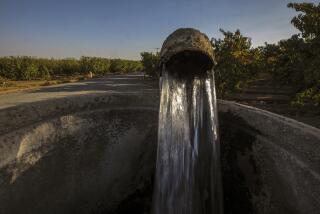Getting Serious on Water
- Share via
The odds are 10 to 1 that California will not experience another dry year in 1989, water agency officials said at drought-contingency conferences last week. Therefore, the betting is good that Californians will not have to suffer the inconvenience of water shortages during the coming year, they said.
But nature sets her own odds. And one key official had a sterner message for California water agencies in assessing the possible water supply not only for 1989 but also for ensuing years, even when precipitation is up to historic norms. Chairman W. Don Maughan of the state Water Resources Control Board said that California cities must get more serious about water conservation. Maughan also criticized, by implication, the managers of the big state and federal water supply projects for being too quick to promise to draw on reservoir reserves to ensure full normal deliveries to their farm customers in dry years.
Maughan’s comments were significant because his five-member board wields immense authority over both water rights and water use in California. If agencies fail to react promptly to drought conditions with adequate programs for conservation, the board might force them to do so under a provision of the California Constitution that prohibits wasteful or unreasonable use of water, Maughan said.
Clearly, California is entering a new age in water management. Maughan’s comments may be a harbinger of the course that the board will take when it sets new water-quality standards for the Sacramento-San Joaquin Delta during the coming year, based on a staff report to be released on Nov. 3. California experts believe that the new standards will be more protective of the delta environment than the current ones are. This, in turn, will determine just how much water the state Water Project and the federal Central Valley Project can export from the delta to customers in the San Joaquin Valley and Southern California.
This year’s drought has hit Northern California much harder than the south, partly because the San Francisco and Oakland municipal systems do not have much reservoir storage capacity for carrying over surplus supplies from one year to the next. Bay Area water users have been cut back by 25% to 30% this year. Southern California agencies generally sought 10% savings on a voluntary basis, but with questionable results, Maughan said.
The state and federal water projects delivered normal-year allotments to most farm customers. One reason is that the projects must pledge water deliveries early in the year because farmers make planting decisions in late winter. As it happened, precipitation was heavy early last winter, and then the year suddenly turned dry. This year the state will wait until Feb. 15 before advising farmers on how much water they are likely to get. Maughan suggested that this decision should be delayed until April 1 in years following a dry season and should be based on conservative forecasts.
The state Department of Water Resources says that it must weigh the low probability of continued drought against the certain economic loss resulting if deliveries were curtailed, perhaps unnecessarily. But the experience of three consecutive dry years is not unprecedented in California. The 1929-35 period saw four drought years interrupted by two below-normal years, in 1930 and 1932.
Whether next year is wet or dry, it seems clear that the state Water Resources Control Board will be putting pressure on all California water dispensers to distribute their supplies more prudently, and to charge prices that severly penalize extravagant use. When it comes to the uncertainty of water supplies, that is about the only safe gamble that one can make.
More to Read
Sign up for Essential California
The most important California stories and recommendations in your inbox every morning.
You may occasionally receive promotional content from the Los Angeles Times.













